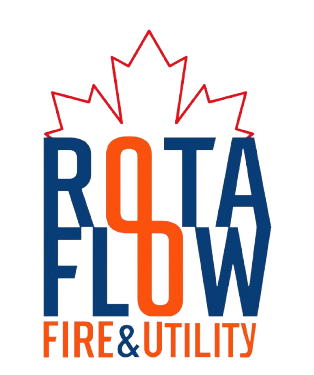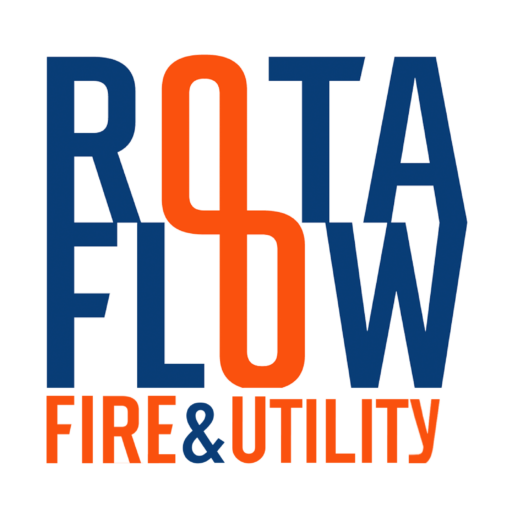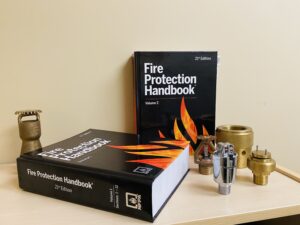Synopsis: Highlighting the main function of fire safety, this article covers the functioning, types, and maintenance of fire sprinkler systems. It clarifies several system versions and the need for routine inspections. Rotaflow Fire & Utility guarantees the best system performance by means of professional installation and maintenance services.
Introduction: Should a fire strike your company, a fire sprinkler system is the most often used and efficient way to put it out. The basic idea of a standard fire sprinkler is straightforward: when one or more sprinklers come into contact with heat above a certain limit—usually 155°F—they open and quickly discharge water straight onto the fire.
With varying maintenance plans and inspection frequencies, fire sprinklers and systems do, in fact, have many variants. Installed inside walls or ceilings, the system comprises sprinkler heads, a water source, and a water distribution pipework system. Though it is not set off by smoke, the sprinkler releases water automatically when a fire is detected. It is both a fire detection and suppression system since it puts out the flames.
Originally invented by Hiram Stevens Maxim in the late 19th century, sprinkler systems have been around ever since. With about 40 million sprinkler heads placed annually, they are currently rather widely used globally. Usually, a system will have water kept under pressure via a network of pipes passing through a building.
Types of Fire Sprinklers Systems
Although the fundamental concept of a sprinkler is straightforward, several different kinds of fire sprinkler systems are used nowadays:
Wet Pipe System: The wet pipe system stores water under pressure in the pipe and releases it instantly via open sprinkler heads, resulting in too much heat.
Dry Pipe System: Unheated or unoccupied buildings or spaces where pipes can freeze and rupture employ dry pipe systems. Held back in a warm environment at a valve is the water. Usually, nitrogen or air fills the sprinkler pipe. The air leaks out of the pipe when a sprinkler head opens from the heat of a fire, therefore guiding the water through the pipe to the sprinkler heads.
Pre-Action System: Usually utilized in high-risk water damage locations, pre-action sprinkler systems are a mix of wet and dry pipe systems. Water is not held in the pipe until a separate type of detection—smoke, heat, flame—allows the water to be released into the pipe upon a fire being detected. Should the sprinklers run from the heat of the fire, the water is then accessible at the sprinkler heads.
Deluge System: Usually found in places like chemical industries, airplane hangars, and flammable liquid storage locations where fast fire damage is a major issue, deluging sprinkler systems are Under these systems, the spray nozzle or sprinkler is open constantly. Another type of detector sets them off, opening a water release valve that floods the entire area with water from every sprinkler.
Standpipe System: Installed throughout a building, standpipe systems comprise pipework and hose connectors to enable firefighters to swiftly and with sufficient water pressure and volume deploy assault hose lines.
Foam-Water: Usually of a wet pipe or deluge type, these systems separate the fuel from the air in fires involving flammable liquids using a solution of foam concentrate and water. The foam envelopes the gasoline’s surface like a smother. The water content of the foam then cools the fuel, and the area of foam covering the fuel inhibits the reignition of the combustible fumes.
The hazards involved will determine the type of system needed; a hospital might need one different from a manufacturing or warehouse, for example. Rotaflow’s fire and life safety experts can help you choose which system best fits the expected threats in your company.
Inspection, Maintenance, and Deficiencies
Fire sprinklers have particular inspection, testing, and maintenance needs, of course, just like all fire and life safety systems. Notice for the Examination, Evaluation, and Upkeep of Water-Based Fire Protection Systems, as published in NFPA 25, contains these specifications:
- inspection of particular parts with daily to five-year frequency range.
- annual, complete check of every system component.
- Five-year internal pipe inspections and hydrostatic (pressure) testing for fire departments.
Besides, the sprinkler heads themselves call for replacement and/or testing. Depending on the sprinkler age, kind, and surroundings, the date for this replacement/testing could vary anywhere from 5 years to 75 years.
Trained inspectors will check all system components and complete all necessary test and maintenance items during fire sprinkler inspections, testing, and maintenance to guarantee your system will run as intended should a fire strike and to find any problems compromising system operations.
Deficiencies
Should imperfections be found, a preferred fire inspection team will work with you to supply the required components and knowledge to fix such problems and keep your system in top running order. Typical shortcomings of fire sprinkler systems include the following:
The buildup of dust and other foreign contaminants, including paint overspray, causes malfunctioning or non-operation of sprinkler heads. While hand cleaning the heads will help to solve this issue, over time the accumulation may become worse and require sprinkler head replacement.
- Missing spare heads or sprinkler head wrench: NFPA mandates a minimum of six spare sprinkler heads in case of emergency repairs, should your system have 299 or fewer overall sprinkler heads. At least two of every kind of sprinkler head utilized in the building must be present. Along with a head wrench, having these available in case of an emergency will help you have the system back running far sooner.
- Equipment or inventory piled excessively near a sprinkler head. NFPA specifies specifications about clearance around sprinkler heads. Ignoring these criteria might create a delay in sprinkler functioning or restrict the water spray pattern, therefore allowing a fire to become much more widespread or even to spiral out of control.
- Corrosion and internal obstruction. Crucially, there is the five-year fire sprinkler inspection. Steel’s water causes rust. This rust could gather in such a way that it results in a buildup blocking the pipe. In galvanized pipe, internal rusting and pitting might result from the water added to the piping system combined with the resident air. Additionally causing obstruction and pinhole leaks is microbiologically induced corrosion. Furthermore, entering the system from the water supply could be rocks and other trash.
- Staying on top of maintenance is absolutely vital since you want to make sure your fire sprinkler system will operate as needed. Frequent maintenance, testing, and inspection guarantees that flaws are found and fixed right away to protect your building should a fire strike.
Installation of fire sprinklers
One should only employ hardware and components approved by third-party testing.
Should retrofitting take place, one must take into account the location of current pipe work, electrical fittings, and mains water pressure. One would perhaps need a water storage system.
Maintaining Top of Mind on the Inspection Cycle of Your System
Trying to keep track of all the several components in a fire and life safety system, as well as the several inspection and maintenance requirements, can be difficult.
Since Rotaflow Fire & Utility handles everything for you, a recommended fire protection provider will make it simple. We will ensure the timely performance of the required maintenance. After helping you choose the ideal system for your particular requirements, our knowledgeable staff will keep you compliant using our tailored, all-encompassing, inspection, testing, and maintenance program. Visit our website for more details.
Courtesy: Farhan Galib, Rotaflow.



